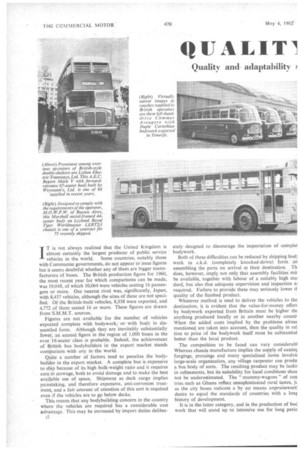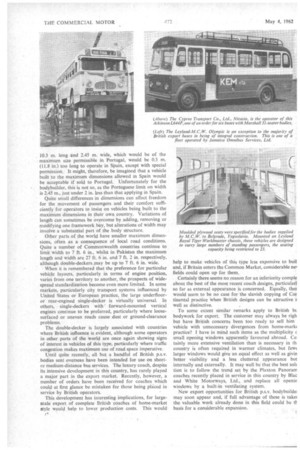QUALIT1 ELLS
Page 114

Page 115

Page 116

If you've noticed an error in this article please click here to report it so we can fix it.
Quality and adaptability t bodywork abroad
—By A. A. TOWNSIN, A.M.I.Mech.E.
IT is not always realized that the United Kingdom is almost certainly the largest producer of public service vehicles in the world. Some countries, notably those with Communist governments, do not appear to issue figures but it seems doubtful whether any of them are bigger manufacturers of buses. The British production figure for 1960, the most recent year for which comparisons can be made, was 19,048, of which 10,064 were vehicles seating 16 passengers or more. Our nearest rival was, significantly, Japan, with 8,437 vehicles, although the sizes of these are not specified. Of the British-built vehicles, 8,338 were exported, and 4,772 of them seated 16 or more. These figures are drawn from S.M.M.T. sources,
Figures are not available for the number of vehicles exported complete with bodywork; or with body in dismantled form. Although they are inevitably substantially fewer, an annual figure in the region of 1,000 buses in the over 16-seater class is probable. Indeed, the achievement of British bus bodybuilders in the export market stands comparison with any in the world.
Quite a number of factors tend to penalize the bodybuilder in the export market. A complete bus is expensive to ship because of its high bulk-weight ratio and it requires care in stowage, both to avoid damage and to make the best available use of space. Shipment as deck cargo implies painstaking, and therefore expensive, anti-corrosion treatment, and a fair amount of attention of this sort is required even if the vehicles are to go below decks.
This means that any bodybuilding concern in the country where the vehicles are required has a considerable cost advantage. This may be increased by import duties deliber P ately designed to discourage the importation of cornplet bodywork.
Both of these difficulties can be reduced by shipping bod: work in c.k.d. (completely knocked-down) form an assembling the parts on arrival at their destination. •Th does, however, imply not only that assembly facilities' mu be available, together with labour of a suitably high stai dard, but also that adequate supervision and inspection a] required. Failure to provide these may seriously lower t1 quality of the finished product.
Whatever method is used to deliver the vehicles to the destination, it is evident that the value-for-money offer( by bodywork exported from Britain must be higher tht anything produced locally or in another nearby countr When the added costs implied by the problems alreac mentioned are taken into account, then the quality in rel tion to price of the bodywork itself must be substantial better than the local product.
The competition to be faced can vary considerabl Whereas chassis manufacture implies the supply of castim forgings, pressings and many specialized items involvii large-scale organization, any village carpenter can produ a bus body of sorts. The resulting product may be lackii in refinements, but its suitability for local conditions shou not be underestimated. The " mammy-wagons " of cou tries such as Ghana reflect unsophisticated rural tastes, jt as the city buses indicate a by no means unpraisewortl desire to equal the standards of countries with a long history of development.
It is in the latter category, and in the production of boe work that will stand up to intensive use for long perio
thout overhaul, that British concerns can and do compete .'ectively, The design problems to be faced are not only fferent from those of vehicles for use in this country, but ffer widely from one market to another. For some coolies it is either necessary to eliminate wood entirely or to .ve it treatedto resist attack by insects, for example, whilst others ferrous parts are subject to severe corrosion unless itably protected. Ease of repair is particularly important lere road conditions make minor damage more probable Ld the nearest skilled body repair -men may be far away. Vehicles destined for continuous use on poor roads quire robust construction, often to the extent that weight
Auction is to some extent a secondary matter. Even for eration on well-surfaced city streets, many overseas operars prefer a somewhat heavier type of vehicle than is voured in this country.
It is significant that the two largest British bus chassis inufacturers have introduced enlarged versions of their evious home market p.s.v, models to take advantage of z 36 ft. X 8 ft. 21 in, overall dimensions now permitted this country, rather than offer their heavier export-type assis of these dimensions on the home market. It seems fortunate that a similar distinction should continue to ply to bodywork for these vehicles. Only a small prortion of British 30 ft. by 8 ft. single-deck bus bodies ilt for export since vehicles of. this size were allowed be operated in this country a decade ago have incorrated basic structures of home-market type.
Variations in the dimensions permitted by different untries are one of the bus bodybuilder's worst headaches developing export markets. The complex situation in 'rope is the subject of a detailed study elsewhere in this ue. Some idea of the difficulties may be obtained by cornring the regulations of. Spain and Portugal. A vehicle 10.3 m. long and 2.45 m. wide, which would be of the maximum size permissible in Portugal, would be 0.3 m. (11.8 in.) too long to operate in Spain, except with special permission. It might, therefore, be imagined that a vehicle built to the maximum dimensions allowed in Spain would be acceptable if sold to Portugal. Unfortunately for the bodybuilder, this is not so, as the Portuguese limit on width is 2.45 m.. just under 2 in. less than that applying in Spain.
Quite small differences in dimensions can affect freedom for the movement of passengers and their comfort sufficiently for operators to insist on vehicles being built to the maximum dimensions in their own country. Variations of length can sometimes be overcome by adding, removing or modifying one framework bay, but alterations of width may involve a substantial part of the body structure.
Other parts of the world have smaller maximum dimensions, often as a consequence of local road conditions. Quite a number of Commonwealth countries continue to limit width to 7 ft. 6 in., whilst in Pakistan the maximum length and width are 27 ft. 6 in. and 7 ft. 2 in. respectively, although double-deckers may be up to 7 ft. 6 in. wide.
When it is remembered that the preference for particular vehicle layouts, particularly in terms of engine position, varies from one territory to another, the prospects of widespread standardization become even more limited. In some markets, particularly city transport systems influenced by United States or European practice, the large underflooror rear-engined single-decker is virtually universal. In others, single-deckers with• forward-mounted vertical engines continue to be preferred, particularly where loosesurfaced or uneven roads cause dust or ground-clearance problems.
The double-decker is largely associated with countries where British influence is evident, although some operators in other parts of the world are once again showing signs of interest in vehicles of this type, particularly where traffic congestion makes maximum use of road space imperative.
Until quite recently, all but a handful of British p.s.v. .bodies sent overseas have been intended for use on shorter medium-distance bus services. The luxury coach, despite its intensive development in this country, has rarely played a major part in the export market. Recently, however, a number of orders have been received for coaches which could at first glance be mistaken for those being placed in service by British operators.
This development has interesting implications, for largescale export of complete British coaches of home-market style would help to lower production costs. This would help to make vehicles of this type less expensive to bull and. if Britain enters the Common Market, considerable nel fields could open up for them.
Certainly there seems no reason for an inferiority comple about the best of the most recent coach designs, particularl so far as external appearance is concerned. Equally, ther would seem to be no case for the slavish copying of Cor tinental practice 'when British designs can be attractive a well as distinctive.
To some extent similar remarks apply to British bu bodywork for export. The customer may always be righ but have British concerns been too ready to sell him vehicle with unnecessary divergences from home-mark( practice? I have in mind such items as the multiplicity c small opening windows apparently favoured abroad. Cei tainly more extensive ventilation than is necessary in th country is often required in wanner climates, but fewt larger windows would give an equal effect as well as givin better visibility and a less cluttered appearance bot internally and externally. It may well be that the best soli tion is to follow the trend set by the Plaxton Panoram coaches recently placed in service in this country by Blae and White Motorways, Ltd., and replace all openin windows by a built-in ventilating system.
New export opportunities for British p.s.v. bodybuildei may soon appear and, if full advantage of these is takei the valuable work already done in this field could be ti basis for a considerable expansion.


































































































































































































































































